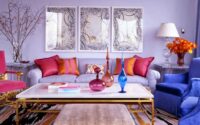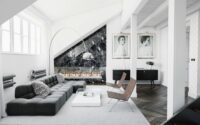500 Sq Ft House Interior Design: Maximizing Space and Style
500 sq ft house interior design presents a unique challenge: crafting a functional and aesthetically pleasing space within a limited footprint. This guide explores innovative solutions for maximizing every inch, from clever storage solutions to strategic furniture arrangements. We delve into color palettes, lighting techniques, and design elements that create a sense of spaciousness and enhance the overall ambiance.
The journey begins with understanding the fundamental principles of space maximization, utilizing furniture that serves multiple purposes, and incorporating light to amplify the sense of volume. We then move on to exploring the nuances of color selection, the art of lighting, and the impact of furniture arrangement on the flow and functionality of the space.
Space Maximization Strategies
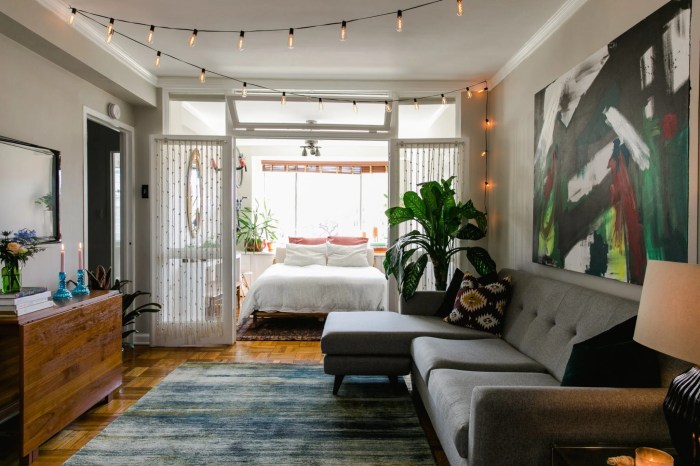
Designing a functional and aesthetically pleasing interior for a 500 sq ft house presents unique challenges. The limited square footage requires clever planning and strategic use of space to create a comfortable and inviting living environment.
Space-Saving Furniture and Storage Solutions
Choosing furniture that serves multiple purposes and incorporates built-in storage is crucial for maximizing space in a small house.
- Multifunctional Furniture:Consider sofa beds, ottomans with hidden storage compartments, and dining tables that can be folded or extended. These pieces allow you to adapt your space based on your needs.
- Vertical Storage:Utilize vertical space by incorporating tall bookshelves, wall-mounted storage units, and floating shelves. This maximizes floor space and keeps belongings organized.
- Under-Bed Storage:Invest in beds with built-in storage drawers or use under-bed storage containers to store seasonal items or bulky belongings.
Maximizing Natural Light in a Small Space
Natural light can make a small space feel larger and more inviting.
- Mirrors:Strategically placed mirrors can reflect light and create the illusion of a larger space. Consider using a large mirror on a wall opposite a window to enhance natural light.
- Light-Colored Walls:Painting walls in light colors such as white, cream, or light gray reflects light and brightens the space.
- Sheer Curtains:Opt for sheer curtains or blinds that allow maximum natural light to filter through while still providing privacy.
Layout Options for a 500 sq ft House
Here are some layout options for a 500 sq ft house, depending on the desired room configuration:
| Layout | Room Configuration | Description |
|---|---|---|
| Open-Concept | Living, Dining, Kitchen | This layout combines the living, dining, and kitchen areas into a single open space, maximizing visual flow and creating a sense of spaciousness. |
| Studio Apartment | Living, Sleeping, Kitchen | This layout combines all living functions into one room, offering flexibility and a minimalist aesthetic. |
| One-Bedroom | Bedroom, Living, Kitchen | This layout provides a separate bedroom for privacy, while the living and kitchen areas are combined for efficiency. |
Color Palette and Lighting
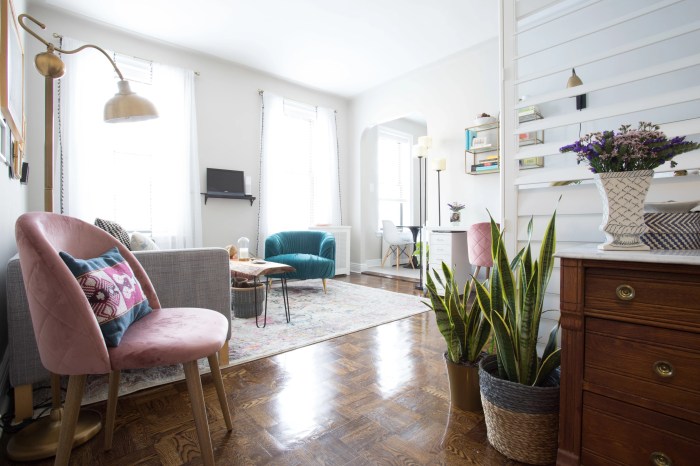
A thoughtfully curated color palette and strategic lighting plan are essential for maximizing the impact of a 500 sq ft home’s interior design. The right combination of colors and lighting can create a sense of spaciousness, enhance the ambiance, and define different areas within the limited space.
Color Palette for a Sense of Space, 500 sq ft house interior design
The color palette plays a crucial role in creating a visually appealing and functional interior. In a small space, light and airy colors are essential for creating a sense of spaciousness and openness.
- Neutral Base:Opt for a neutral base color for the walls, such as white, cream, or light gray. These colors reflect light, making the space feel larger and brighter.
- Accent Colors:Introduce accent colors through furniture, artwork, and textiles to add pops of personality and visual interest. Consider using cool colors like blues and greens, which have a calming effect and can make a space feel larger.
- Warm Accents:While cool colors can enhance the sense of space, warm accents like yellows and oranges can add warmth and vibrancy. Use these strategically to create focal points or highlight specific areas.
Light and Dark Colors for Visual Interest
Light and dark colors can be used strategically to create visual interest and define different areas within a small space.
- Darker Walls:Darker walls can create a cozy and intimate atmosphere in smaller areas like a bedroom or a reading nook.
- Light Furniture:Pair dark walls with light-colored furniture to create contrast and prevent the space from feeling too enclosed.
- Light Ceilings:Maintain a light ceiling to create a sense of height and openness.
Natural and Artificial Lighting
Natural and artificial lighting work together to create a dynamic and inviting atmosphere.
- Maximizing Natural Light:Utilize windows to bring in as much natural light as possible. Keep window treatments light and airy to allow maximum light penetration.
- Strategic Placement of Artificial Lighting:Use a combination of ambient, task, and accent lighting to create a multi-layered lighting scheme.
- Ambient Lighting:Overhead lighting, such as recessed lights or chandeliers, provides general illumination.
- Task Lighting:Focus on task lighting for specific areas, such as reading nooks, workspaces, and kitchen countertops.
- Accent Lighting:Use accent lighting to highlight artwork, architectural features, or decorative elements.
Visual Representation of Lighting Fixtures
Different lighting fixtures can significantly impact the feel of a space.
- Pendant Lights:Pendant lights, suspended from the ceiling, can add a touch of elegance and create a focal point.
- Recessed Lighting:Recessed lights provide a clean and minimalist look, while also offering excellent illumination.
- Track Lighting:Track lighting allows for flexible positioning and can be used to highlight specific areas or create a dramatic effect.
- Floor Lamps:Floor lamps offer a versatile lighting solution, providing both ambient and task lighting.
- Table Lamps:Table lamps create a cozy and inviting atmosphere, perfect for bedside tables or living room corners.
Furniture Selection and Arrangement
In a compact 500 sq ft house, every piece of furniture needs to serve a dual purpose: functionality and aesthetics. The key is to choose furniture that is both practical and visually appealing, contributing to a sense of spaciousness and style.
Furniture Pieces for a 500 sq ft House
Selecting furniture for a small space requires careful consideration. Here are some essential pieces that are both functional and visually appealing:
- Multi-functional Sofa:A sofa bed or a sofa with built-in storage can provide both seating and sleeping space or extra storage for bedding, books, or other items. For example, a sofa bed with a pull-out trundle bed can accommodate guests, while a sofa with built-in storage can keep clutter at bay.
- Coffee Table with Storage:A coffee table with drawers or shelves can provide additional storage for remote controls, magazines, or other essentials. A coffee table with a lift-top feature can double as a dining table, saving valuable space.
- Wall-mounted Shelving:Wall-mounted shelves are an excellent way to maximize vertical space and create a visually appealing display for books, decorative items, or plants. They also help to free up floor space, making the room feel more spacious.
- Folding Table:A folding table can be used for dining, working, or crafting, and can be easily stored away when not in use. It’s a great option for small spaces where versatility is crucial.
- Mirrors:Mirrors can create the illusion of more space by reflecting light and expanding the visual field. Placing a mirror opposite a window can further enhance the effect.
Furniture Arrangement Strategies
The arrangement of furniture plays a crucial role in maximizing space and creating a sense of flow. Here are some strategies to optimize space and create a welcoming atmosphere:
- Create Defined Zones:Divide the space into functional zones, such as living, dining, and sleeping areas. Using rugs, different lighting, or furniture placement can help define these zones without physical barriers. For example, a rug can delineate the living area from the dining area, while a pendant light over the dining table can create a focal point.
- Maximize Corner Space:Utilize corner space by placing a small desk, a bookshelf, or a plant. This maximizes vertical space and adds visual interest.
- Use Multi-functional Furniture:Employ furniture pieces that serve multiple purposes, such as a sofa bed, a coffee table with storage, or a folding table. This minimizes the number of furniture pieces needed and maximizes space.
- Keep Traffic Flow Clear:Ensure that walkways are clear and unobstructed. Avoid placing furniture in the middle of walkways, and consider using furniture with rounded edges to minimize potential collisions.
- Create a Focal Point:Draw the eye to a specific area by placing a statement piece, such as a large artwork or a unique rug, in a prominent location. This can create a sense of balance and visual interest.
Multi-functional Furniture
Multi-functional furniture is essential for maximizing utility in a 500 sq ft house. Here are some examples of furniture pieces that serve multiple purposes:
- Sofa Bed:A sofa bed combines seating and sleeping functionality, ideal for small spaces where guests are frequent. It eliminates the need for a separate bed and maximizes space.
- Storage Ottoman:An ottoman with built-in storage can serve as a footrest, extra seating, or a place to store blankets, books, or other items. It’s a versatile piece that adds functionality and style.
- Murphy Bed:A Murphy bed folds away into a wall cabinet, providing a sleeping space that can be easily hidden when not in use. It’s a space-saving solution that maximizes floor space.
- Wall-mounted Desk:A wall-mounted desk can be folded away when not in use, freeing up valuable floor space. It’s an ideal solution for small spaces where a dedicated desk area is limited.
- Ladder Shelf:A ladder shelf can be used as a bookshelf, a display shelf, or even a coat rack. It’s a versatile piece that adds vertical storage and a touch of rustic charm.
Mood Board: Furniture Styles
Here is a mood board showcasing different furniture styles suitable for a 500 sq ft house: Modern Minimalist:This style features clean lines, simple forms, and a neutral color palette. It’s ideal for creating a sense of spaciousness and airiness in a small space.
A minimalist sofa with sleek legs, a glass coffee table, and a wall-mounted bookshelf would be perfect examples. Mid-Century Modern:This style is characterized by organic shapes, geometric patterns, and a focus on functionality. It’s a great choice for creating a stylish and comfortable atmosphere.
Designing a 500 sq ft house requires a keen eye for maximizing space and functionality. While a smaller footprint can be challenging, it also presents an opportunity to create a cozy and inviting atmosphere. If you’re looking for inspiration, consider exploring the possibilities of a larger space like a 1800 sq ft house interior design.
The principles of efficient layout and smart storage solutions that are crucial in a 500 sq ft house can be applied to larger homes as well, resulting in a spacious and well-organized living environment.
A classic mid-century sofa with tapered legs, a wooden coffee table with a geometric design, and a globe pendant light would be suitable for this style. Scandinavian:This style emphasizes simplicity, functionality, and natural materials. It’s perfect for creating a cozy and inviting space.
A light-colored sofa with a simple design, a wooden coffee table with a natural finish, and a sheepskin rug would complement this style. Industrial:This style incorporates raw materials, exposed brick, and metal accents. It’s ideal for creating a bold and edgy look.
A leather sofa with metal legs, a reclaimed wood coffee table, and a vintage industrial lamp would be fitting for this style. Bohemian:This style is characterized by eclectic mix of textures, colors, and patterns. It’s perfect for creating a unique and personalized space.
A velvet sofa with vibrant colors, a vintage rug with intricate patterns, and a collection of plants would be perfect examples.
Designing a 500 sq ft house can be challenging, especially when it comes to maximizing space and creating a visually appealing environment. Fortunately, 3d house interior design software can be a game-changer. These programs allow you to experiment with different layouts, color palettes, and furniture arrangements, giving you a realistic preview of how your design will look before you even start building or buying anything.
With the help of this software, you can create a functional and stylish space in your 500 sq ft home, maximizing every inch.
Material Selection and Finishes
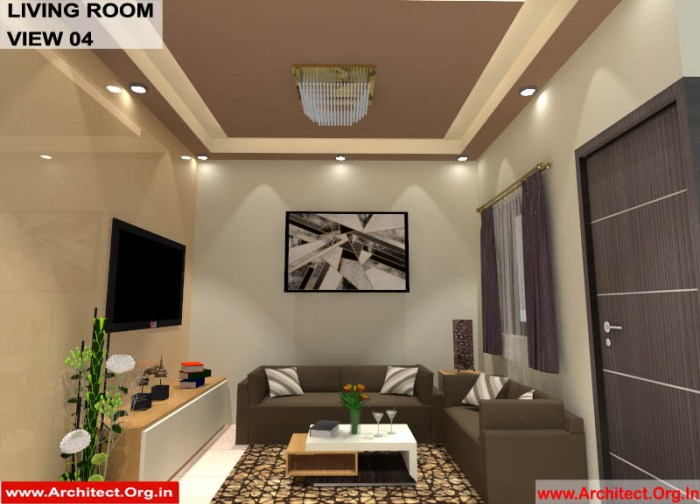
Choosing the right materials and finishes for your 500 sq ft house is crucial for creating a space that is both functional and aesthetically pleasing. It’s important to select materials that are durable, easy to maintain, and align with your design vision.
Sustainable and Eco-Friendly Materials
Sustainable and eco-friendly materials are becoming increasingly popular in interior design, as they minimize environmental impact and promote healthy living spaces. Here are some examples:
- Bamboo:A fast-growing, renewable resource that is strong and durable. It can be used for flooring, furniture, and even countertops.
- Cork:A natural, sustainable material that is soft underfoot and provides excellent insulation. It is often used for flooring and wall coverings.
- Recycled Glass:Recycled glass can be incorporated into countertops, tiles, and even furniture. It adds a unique touch and reduces waste.
- Wool:A natural, breathable fiber that is hypoallergenic and fire-resistant. It is often used for carpets and upholstery.
- Linoleum:A sustainable flooring option made from natural ingredients like linseed oil, wood flour, and rosin. It is durable, easy to clean, and comes in a variety of colors and patterns.
Flooring Options for a 500 sq ft House
Flooring is a significant aspect of interior design, affecting both the aesthetics and functionality of a space. Here’s a comparison of different flooring options suitable for a 500 sq ft house:
| Flooring Type | Pros | Cons | Cost (per sq ft) |
|---|---|---|---|
| Hardwood | Durable, elegant, adds value to the home | Expensive, requires maintenance, susceptible to scratches and dents | $5-$15 |
| Laminate | Durable, water-resistant, affordable | Not as natural as hardwood, can be difficult to repair | $2-$5 |
| Tile | Durable, easy to clean, water-resistant | Can be cold underfoot, can be slippery | $3-$10 |
| Carpet | Soft underfoot, good insulation, affordable | Can trap allergens, requires regular cleaning, can be stained | $2-$8 |
| Vinyl | Water-resistant, affordable, easy to maintain | Can be less durable than other options, may not be as aesthetically pleasing | $1-$4 |
Creating a Sense of Flow
In a small space, it’s essential to design a layout that promotes a smooth flow between different areas of the house. This not only makes the space feel larger but also creates a more inviting and functional environment.
Color, Lighting, and Furniture Arrangement
Color, lighting, and furniture arrangement play a crucial role in creating a sense of continuity. By using a cohesive color palette, incorporating strategically placed lighting, and selecting furniture that complements the overall design, you can visually connect different areas of the house, making it feel more spacious and inviting.
- Color Palette:A cohesive color palette can create a sense of flow by visually connecting different areas of the house. Using a light and airy color palette, such as white, cream, and pale blues, can make a small space feel larger and more open.
Consider using accent colors to add pops of personality and interest. For example, a bright accent wall in a living room can create a focal point and visually connect it to the adjacent dining area.
- Lighting:Lighting plays a significant role in creating a sense of flow. Using a combination of natural and artificial light can help to illuminate the space and create a sense of openness. For example, large windows can allow natural light to flood the space, while strategically placed lamps can highlight specific areas.
By using consistent lighting throughout the house, you can create a cohesive and inviting atmosphere.
- Furniture Arrangement:Furniture arrangement can also contribute to a sense of flow. Using furniture to create distinct areas while still allowing for movement between them is crucial. For example, in a small living room, consider placing a sofa and coffee table in the center of the room, creating a distinct seating area.
A bookcase or other tall furniture piece can be used to divide the living room from a dining area, creating a sense of separation while still allowing for visual connection.
Concluding Remarks: 500 Sq Ft House Interior Design
Designing a 500 sq ft house interior is a rewarding endeavor that requires a blend of creativity, practicality, and a keen eye for detail. By embracing smart design strategies, you can transform a small space into a haven that is both functional and visually appealing.
Remember, every inch counts, and with careful planning and a touch of ingenuity, you can create a home that reflects your unique style and provides a sense of comfort and well-being.
Questions and Answers
What are some common space-saving furniture options for a 500 sq ft house?
Some popular options include Murphy beds, sofa beds, ottomans with storage, and wall-mounted shelves.
How can I create a sense of spaciousness in a small bathroom?
Use light colors, mirrors, and good lighting to make the space feel larger. Consider a glass shower enclosure to visually expand the area.
What are some budget-friendly design solutions for a 500 sq ft house?
Look for affordable furniture at thrift stores or online marketplaces, utilize DIY projects, and incorporate repurposed materials for unique decor elements.


